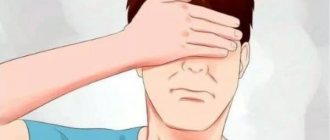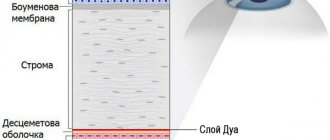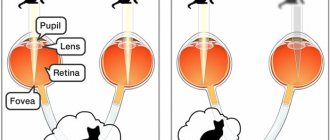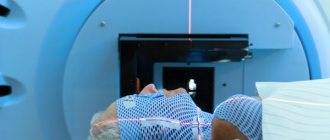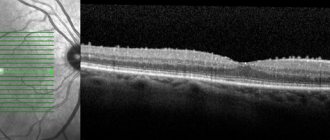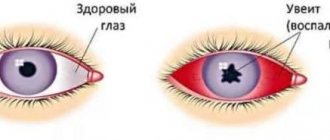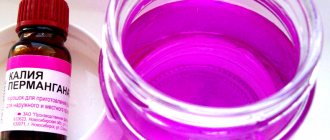08/15/2018 The pinguecula of the eye is a benign formation that occurs on the conjunctival membrane of the eye. It is a painless growth of white or yellowish color, which is most often located on the border with the inner edge of the cornea, that is, in the inner corner of the eye closer to the bridge of the nose. Almost constantly, the process develops on both sides simultaneously.
- inguecula of the eye
- Causes of pinguecula of the eye
- Signs of pinguecula
- Pinguecula removal
The formation of the pinguecula of the eye occurs under the influence of aging of the body, during which age-related deviations in metabolism occur. Thus, with age, the metabolism of lipids and proteins is disrupted, which leads to excessive accumulation of these substances at the microscopic and tissue levels of organization. Fats and proteins accumulate where we do not see them - in the tissues of internal organs and their cells, but what we can see is just the mentioned formation on the conjunctiva.
Treatment
Pinguecula has a long chronic course and a favorable prognosis, is not prone to degeneration and in most cases does not require any treatment. If you experience symptoms of eye irritation or dryness, you should make an appointment with your doctor to determine the exact cause of these complaints. Based on the results of the examination, if necessary, the doctor may prescribe medications to moisturize the eyes (“artificial tears”), anti-inflammatory eye drops if there are signs of an inflammatory reaction.
If the pinguecula is inflamed, patients using contact lenses should temporarily stop wearing them so as not to injure the mucous membrane of the eyes.
We do not recommend that patients use traditional methods of treating pinguecula (blueberries, aloe, honey, etc.), because they are not effective and often cause allergic reactions, aggravating the condition.
If the pinguecula causes physical or psychological discomfort to the patient, it can be removed surgically or using a laser. The operation is performed on an outpatient basis and does not require special preparation.
Symptoms of pinguecula
The main manifestations of the disease are:
- The formation on the mucous membrane of the eye of a small yellowish island of thickened tissue that stands out against the background of the normal color of the conjunctiva.
- Feeling of dryness, sand, or foreign body in the eye;
- Burning, itching;
- A scratching sensation when blinking;
- Local redness around the tumor;
If inflammation is associated with the pinguecula, the patient may be bothered by mucous or purulent discharge from the eye and swelling of the formation.
Advantages of treatment at MGK
All patients of the Moscow Eye Clinic are guaranteed to receive attentive attention from medical staff and a choice of the most appropriate treatment methods.
The clinic is equipped with the most modern medical equipment, which ensures the highest level of diagnosis of any eye pathologies, even at the initial stage of the disease, and the possibility of making an erroneous diagnosis is excluded.
The Moscow Eye Clinic employs leading domestic specialists who have sufficient experience in treating eye diseases. Our specialists love their work and always strive to achieve the best treatment results.
Pinguecula removal in the clinic is performed on an outpatient basis, on a one-day basis. The operation is painless, performed under local drip anesthesia, and has a short recovery period (several hours). After removal of the formation, our specialists will give recommendations to prevent the reappearance of pingueculae.
Diagnosis and symptoms
At its core, a pinguecula is just an accumulation of adipose tissue.
Despite the nature of the tumor, it cannot degenerate into cancer cells and does not affect the quality of life and visual acuity.
Special diagnostics include examining the damaged eye at a slit lamp, as well as testing visual acuity.
You can make such a diagnosis yourself, because changes in the tissues of the eye shell are noticeable upon visual examination. A visit to an ophthalmologist usually occurs precisely in the acute stage, when, in addition to fatty deposits, discomfort is observed. This article will tell you about the causes of retinal detachment.
These include:
- Feeling of burning and dryness in the eye.
- Redness of the capillaries.
- Swelling of the eyelid.
- Cloudiness of the cornea.
- Increased lacrimation.
- Feeling of a foreign object in the eye.
The indications for treatment of pinguecula are precisely the accompanying symptoms. Sometimes the pinguecula is removed to remove a cosmetic defect of the eye, but usually this disease is asymptomatic and does not require medical correction.
Diagnosis of pinguecula
The diagnosis is made based on the results of anamnesis and visual examination of the conjunctiva. The presence of a small round yellow formation allows one to suspect a pinguecula, but to differentiate it from other ophthalmological pathologies, additional examination methods are required.
Diagnostic methods:
- Biomicroscopy;
- Fluorescein angiography;
- Optical coherence tomography;
- Ferning test.
Laboratory tests are not required to confirm pinguecula, but if there is severe redness of the conjunctiva and symptoms of inflammation, a bacteriological examination is performed to confirm or exclude the presence of bacterial microflora.
Prevention of pinguecula
To prevent the formation of pinguecula, it is necessary to protect your eyes from bright sunlight with sunglasses that do not transmit UV waves. You can also use a hat to protect your eyes from the bright sun - a cap with a long visor or a hat with a wide brim.
Prevention of pinguecula includes protecting the visual organs from irritating factors - dust, smoke, chemicals, allergens. People working in hazardous industries must follow all kinds of safety rules.
Strengthening the immune system and normalizing metabolism plays an important role in prevention. Therefore, nutrition should include sufficient amounts of vitamins, minerals and antioxidants, and exclude large amounts of animal fats.
Causes and development factors
The main patients treated with pinguecula are elderly people, which indicates the connection of the disease with senile changes in the body. All tissues begin to gradually lose their properties and this also affects the organs of vision. The gradual degeneration of the conjunctiva contributes to the disruption of its structure and the deposition of proteins and lipids on the surface that form this neoplasm. Slow metabolism and metabolic disorders also have a strong impact, in which many substances are poorly excreted from the body and begin to settle in the tissues of internal organs. In many patients, degeneration of collagen fibers develops in the stromal part of the conjunctiva and this leads to thinning of the epithelial layer.
Some time ago it was believed that pinguecula could form due to frequent wearing of contact lenses. However, at the moment there is no confirmation of this hypothesis.
Currently, the exact mechanisms of development of pinguecula remain unknown, but scientists are inclined to believe that the disease is formed due to frequent mechanical damage and irritation of the conjunctiva. This can happen under the influence of the following factors:
- ultra-violet rays;
- work in hazardous enterprises (chemical, pharmaceutical, mines, factories, sawmills, construction sites);
- arriving in windy, dusty or smoky areas;
- low air humidity;
- chronic conjunctivitis;
- infrared irradiation.
Most often, people who live in sunny countries and spend a lot of time outdoors suffer from pinguecula. This especially affects patients whose working day is spent outdoors. Ultraviolet rays stimulate the production of a special protein called elastin by fibroblasts, which accelerates conjunctival degeneration.
Harmful working conditions greatly affect the entire body and the visual organs, including
In some cases, pigvecula is not an independent disease, but develops secondary to Gaucher disease or glucosylceramide lipidosis. This is a hereditary pathology that leads to the accumulation of fatty deposits in various organs.
Is it possible to get rid of pinguecula of the eye using folk remedies?
Pinguecula cannot be cured using folk remedies alone. Its removal is possible only surgically. Alternative medicine recipes can only be used as auxiliary techniques in the treatment of such eye pathologies. The use of alternative medicine recipes will help stop the development of pinguecula only if a course of therapy prescribed by a doctor is carried out simultaneously with it.
Pinguecula can be reduced if you strengthen your vision with the help of natural compounds, which include juices:
- blueberries;
- beets;
- carrots.
They increase immunity, strengthen blood vessels, improve blood composition, and help improve blood circulation in the conjunctiva. To increase the effectiveness of drug control against pinguecula, you can introduce blueberries in any form into your diet. It should be eaten raw as much as possible, as this berry has a beneficial effect on vision. You can dry or freeze the berries for future use, then make a healing infusion from them and take them several times a day. To reduce pinquecula, you need to eat at least 100 g of fresh blueberries per day.
In addition to ingesting blueberries, you can use juice and infusions for compresses that are applied to the eyelids. The procedure is carried out for 15 minutes two to three times a day. Also, beets can be used as an additional therapy, which will help cleanse the blood of proteins and fats from which pinguecules are formed. It should be eaten every day on an empty stomach, at least 100 g per day. You can also make compresses from it that will nourish the mucous membrane and relieve irritation caused by the pinguecula.
When choosing any recipe for such an unconventional technique to combat pinguecula, you must first consult with your doctor.
Symptoms of the disease
The initial stage of pinguecula formation is asymptomatic. When the growth increases slightly in size, the patient may be bothered by the following manifestations:
- Redness of the affected area (hyperemia).
- The appearance of dry eye syndrome.
- Discomfortable sensations similar to the feeling of a foreign object getting into the eye.
- Edema formation.
- Blinking is accompanied by eye irritation or a scratching sensation.
Such symptoms appear when the inflammatory process begins. Most often, this does not happen and the pinguecula is noticeable only visually.
References
- ^ a b c d e
John F., Salmon (2020).
"Conjunctiva". Kanski's Clinical Ophthalmology: A Systems Approach
(9th ed.). Edinburgh: Elsevier. ISBN 978-0-7020-7713-5. OCLC 1131846767. - Miron, Yanov; Jay S., Duker (2019). "Diseases of the cornea and ocular surface." Ophthalmology
(5th ed.). Edinburgh: Elsevier. p. 206. ISBN 978-0-323-52821-4. OCLC 1051774434. - ^ a b
Bowling, Brad (24 March 2015).
Kanski's eBook on Clinical Ophthalmology: A Systematic Approach
. Elsevier Health Sciences. paragraph 162. ISBN 9780702055744. - Weedon, David (2010). Weedon's Skin Pathology
. ISBN 978-0-7020-3485-5. - Sutphin, John (ed.). 2007-2008 Course of Basic and Clinical Sciences Section 8: External diseases and cornea
. American Academy of Ophthalmology. item 365. ISBN 1-56055-814-8. - Kisling, David (06/26/2010). "Eye growth and bumps, often pinguecula." Received 2018-02-21.
- Ravazzoni L., Ghini S., Macri A., Rolando M. (1998). "Prediction of tolerance to hydrophilic contact lenses using the tear production test." Clinical and Experimental Ophthalmology
.
236
(5):354–358. Doi:10.1007/s004170050090. PMID 9602319. S2CID 9448528. - “pingu-, pingue-, pingui-“. Information in English
. Publications for senior scribes. Received 2018-02-21. - ^ a b c
"Pingvecula - EyeWiki".
eyewiki.aao.org
.
Causes
According to many doctors, pinguecula is a sign of aging of the conjunctiva, and therefore is often recorded in older people. In addition, the appearance of pinguecula may be associated with certain occupational hazards that directly affect the eyes, constant irritation of the conjunctiva under the influence of harmful atmospheric factors (dust, wind, smoke).
Ultraviolet radiation and a hot, dry climate can contribute to the development of the disease; for this reason, pinguecula are sometimes recorded in people who spend long periods of time outdoors. The formation does not affect vision, although it can cause irritation and inflammation of the conjunctiva.
It should be noted that the scientific literature to date has not described cases of pinguecula associated with wearing lenses.

